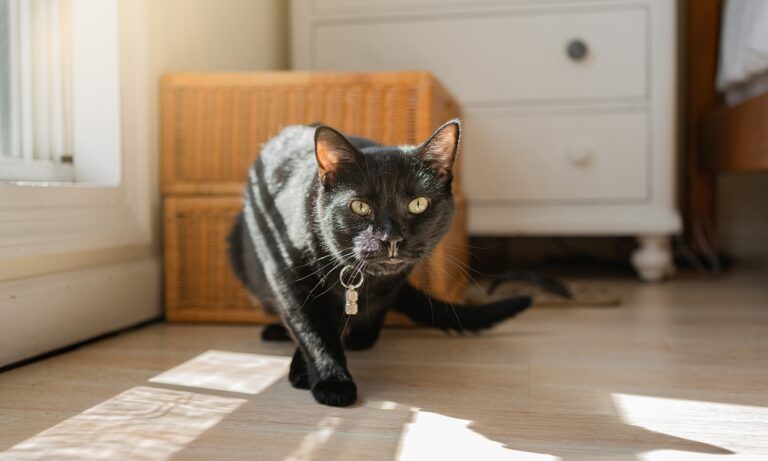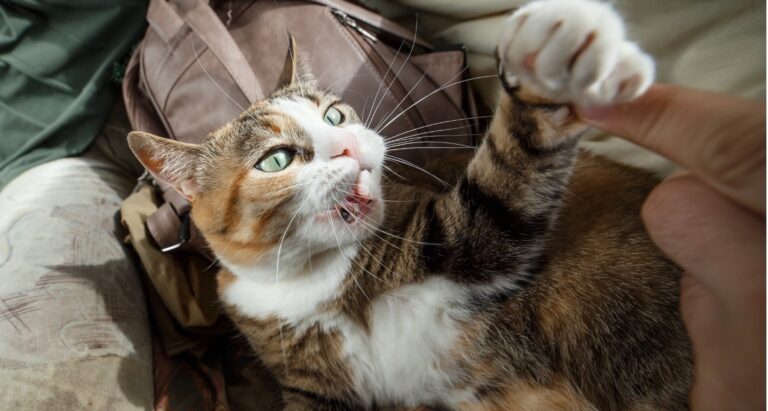Help, My Cat Hates Visitors

Photo by Dmitry Bruskov/iStock/Thinkstock
What makes your darling, sweet cat companion switch from snuggly to snarly when visitors arrive? Why is it your friends and family never see the “real” kitty you live with? And, is there anything you can do to change it?
Many cat owners keep their pet indoors at all times to keep them safe and healthy. By staying inside, cats are protected from predators, vehicles and diseases — which is a great thing. But one potential downside to the situation is that indoor cats may live in a small “territory” with very little variety from day to day. We all get used to standard things in our environments, and expect some consistency. Some of us are more accepting of change, and some are not. Cats are no different.
We know one reason for differences in acceptance of new things is being exposed to new things (scientists and animal trainers call these “novel stimuli”) during certain periods of development when the animal is more “open” and accepting to learning. For kittens, that period is the ages between 3 to 8 weeks. Kittens who are kept away from people and do not get early exposure may start life with a deficit for accepting strangers. Additionally, past experiences with people will have an effect — pleasant experiences make cats think people are good, and less happy experiences may make cats afraid of new people.
Not all kittens are given opportunities for multiple safe encounters with people at that early age. Consequently, many cats are undersocialized, which means they are not comfortable with new or unusual things. A cat who lives with just one, two or only a few humans may find several new humans very frightening.
Your Cat's Point Of View
Cats, like canines, have a much more intense sense of smell than people do. They can easily notice when someone coming into the living room is not one of the “regulars” in the home. And some people bring along very strong scents from smoking, perfume, medications or foods that might be strange to the cat.
It is for this reason that some cats urinate on surfaces where “new” people have sat. The cat may find the smell alarming, which results in stress and an increased need to urinate, and/or the cat may attempt to cover the unfamiliar scent with his own.
A cat’s sense of hearing is also acute. Your cat may perceive a different car as it pulls into the driveway and a new voice at the front door. So, well before a guest comes close enough to touch your cat, kitty may have made the determination that this new person who smells and sounds differently than you do, is scary. Some cats flee, while some freeze in their favorite spot, hoping no one notices them.
When the visitor appears nearby, peering at the cat with interest, it may seem like an ambush to your cat. If the “outsider” reaches toward the cat, it might be enough to push kitty over the threshold of being able to stay calm. The result can be a puffed-up cat making a growling sound, hissing, swatting with paws, scratching with claws, and/or dashing away. Of course, you and your visitor know there was no real threat to the cat’s safety. But the cat may believe he was seriously close to danger. So, if that person returns, the result might be a quicker or more dramatic reaction to the sounds and smells of the “outsider.”
Helping Your Cat Cope
What’s a good cat owner to do? You have several options.
1. Be Proactive for Your Cat
While you may be eager to have your new friends over, your cat must feel safe in his home. If you know your cat cannot handle visitors yet, either make an appointment to meet your family or friends at a nearby café, or create a safe, quiet place for your cat to stay while you have visitors at home. Above all, do not allow new people to reach for, tease or scold your cat — even with the best of intentions. Any of those activities could look like an attack to your cat. It is your job to manage the situation and keep your cat from having that kind of experience until he is ready.
2. Make an Assessment
Do you have a true scaredy-cat, or just a shy one? What seems to be scariest for your cat — loud sounds, motors, strong odors, smokers, too much movement, men, women or children? You will want to start by expanding your cat’s group of “friends” with someone least likely to upset your cat. If kids are scary to your cat, do not start by hosting your niece’s birthday party of 15 noisy kids!
3. Do You Need To Make a Change?
If you are a non-social, retired widow living in a small apartment where you do not host guests, this could be a lower priority. But, if you have plans for adding a roommate, spouse, children or aging parent to the household sometime in the future, start early introducing new people for short periods and in subtle, pleasant ways.
4. Learn Cat Body Language
Knowing the meaning of subtle changes in pupils, ear positions, tail movements and the way whiskers are held will give you insight into what your cat is feeling.
5. Know Thy Cat
Even for cats who like people, there are sometimes “off limits” areas. Some cats can handle about three minutes of touching and petting, and then they are no longer interested. Continuing to pet or trying to reconnect with a prickly feline can result in the cat resorting to aggressive tactics to disengage. Some cats are fine with butt scratches and belly rubs — but not many are thrilled receiving them from someone new. Even if kitty allows you to do them, advise your visitors to be more conservative. Allow your cat to approach at her discretion. Offer a neutral, relaxed hand, but don’t reach or grab. Giving your cat a choice in determining what will happen goes a long way to avoiding aggression and to building trust.
6. Teach Your Visitors How To Throw ‘Eye Kisses'
Slow blinking and avoiding direct eye contact can let your cat know that visitors are not threatening.
7. Make Happy Associations
This is called “counter-conditioning.” If your cat believes people are scary, you can pair something your cat absolutely loves with the arrival of visitors. In order for this to work well, you also need to keep the intensity of the visitor low for your cat. Perhaps the visitor could come into the home, but sit far away from your cat while you feed high-value cat treats, or engage in an activity the cat loves. For some cats that might be playing with a cat feather wand toy or being brushed; for others, it might be a catnip party.
Keep the visitor in a neutral position away from the cat, and continue the activity while the visitor is present. Pick a cue word you can say to have the visitor quietly leave the room or the home as you stop whatever the good thing or activity is. You are pairing the arrival of the visitor with something your cat loves. So when the visitor leaves, the good thing (and all good attention) should also stop. Doing this regularly can make the cat feel better about the visitor’s arrival because it “makes” the good thing happen.
8. Expand the Program
Once you have done this a few times, begin to broaden the number and types of visitors you have. How many and how often is dependent upon how your cat reacts. If the cat is staying relaxed in the initial sessions, you can change one aspect of the visits at a time. Either the visit can be a bit longer, or the visitor might sit a bit closer to the cat, or you might invite someone different. It is key not to push things too fast.
9. Find Creative Ways To Include a New Person in Regular Activities
A new person could be in the home for your cat’s dinnertime, or come over and just read a book quietly while you are home. The quiet activity like reading means very little eye contact or physical interaction with your cat. Sometimes 15 to 30 minutes is enough for a cat to decide the person is “safe” and OK to approach.











